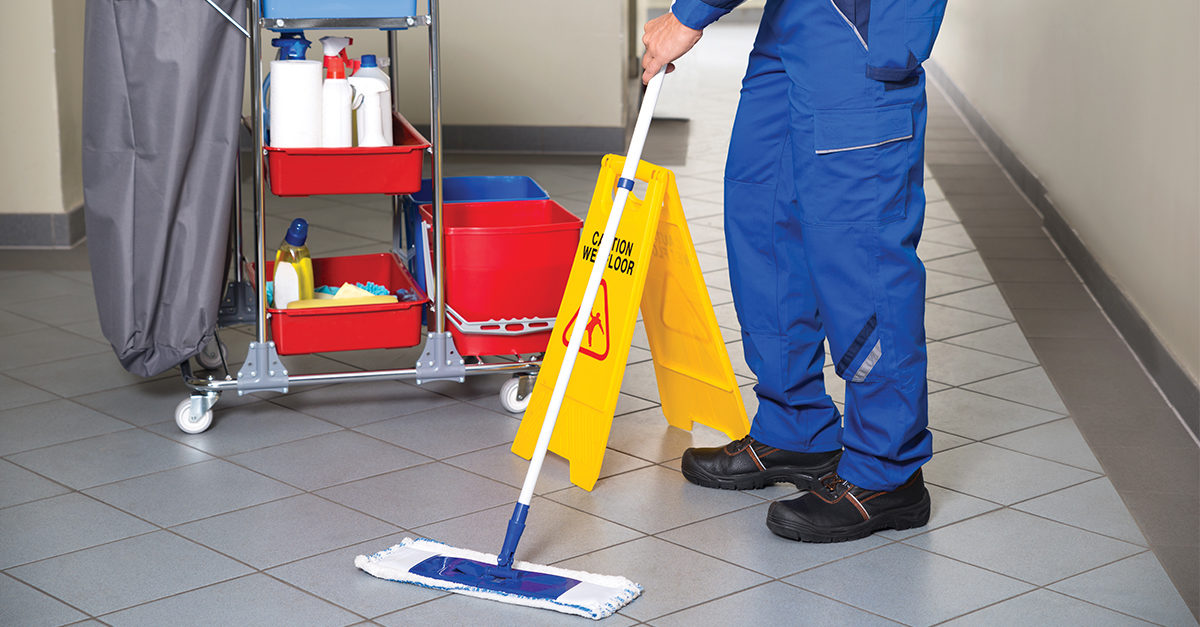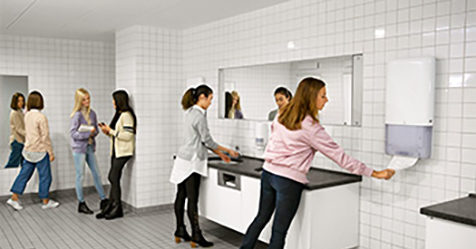There’s more to cleaning than simply knowing how to clean. Cleaners must also know how to take care of cleaning tools and use them properly to limit cross-contamination. Because cross-contamination often occurs when workers are pressed to save time or preserve resources, an improperly cleaned facility can be just as dirty, if not dirtier, than one that is not cleaned at all.
Proper restroom tool management is essential to preventing the spread of germs, not only within a business, but within the restroom itself. No matter how small the area, if cleaning staff are not properly taking care of equipment—such as tools and cleaning chemicals—contaminants will likely spread to other areas of the building.
When in doubt, utilize a “clean zone” approach when it comes to maintaining restroom tools. Identify what tools to use with particular cleaning chemicals and surfaces and the correct process to use them. This not only leads to a higher level of clean in your restroom, but to savings on unnecessary tool replacement, excess chemical usage, and time spent on rework.
Here’s a quick guide on how to effectively identify and manage the proper cleaning tools, cleaning chemicals, and optimal cleaning process for your facility:
Proper Cleaning Tools
Each area within a restroom deserves a different tool. You wouldn’t clean your kitchen table with the same wipe you use on the kitchen floor, so why would you do the same in the restroom?
Color code the facility’s cleaning tools. To ensure employees know which tools to use on particular restroom surfaces, make sure to color code them. For example, white microfiber cloths could be designated for sinks and counters, while gray is designated for toilets or urinals. This not only provides an easy visual reference for employees to identify which cleaning tools to use, but it also offers an easy way for supervisors to recognize if someone is using the wrong tool in a specific area and quickly correct the mistake.
Additionally, color coding teaches employees not to use tools dedicated to the restroom in other areas of the facility, which reduces cross-contamination. For tools like mops or mop buckets, the easiest way to color code is to apply color-coded stickers to the handle or side of the tool. The sticker should be large enough to be visible to a supervisor or manager walking by and positioned between where an employee would place their hands on the mop.
Use microfiber cloths and mops. Having the most effective tools also reduces cross contamination. According to Rubbermaid Commercial Products Inc., microfiber products remove more microbes, dust, and dirt than traditional cleaning tools. Microfiber can also absorb seven times its weight in water, leading to substantially reduced cleaning chemical and water use.
Dirty mop heads are another contributor to cross-contamination that can be contained with proper maintenance. They are a breeding ground for germs and bacteria, and do little more than push dirt around. The key to reducing cross-contamination is making sure that dirty mop heads and wipes are properly cleaned so staff always has clean and sanitized supplies available.
Depending on the facility in which you work, microfiber mop heads and wipes can be washed together with hot water and an effective cleaning solution. With proper maintenance, they can last more than 400 wash cycles. But keep in mind, microfiber will lose its magnetic qualities over time and/or begin fraying, so a replacement schedule will ensure they work as intended.
If you don’t have the manpower or equipment to properly launder microfiber cleaning tools effectively, consider outsourcing to a company that can do it for you. Many companies offer a variety of flexible microfiber rental delivery programs on a daily, weekly, or monthly basis, depending on your needs. Rental programs can also help limit the risks associated with laundering in house by making sure the products are cleaned effectively and in line with U.S. Centers for Disease Control and Protection (CDC) guidelines.
Use dual-chamber mop buckets. When employees mop floors with traditional mop buckets, they submerge the mop heads repeatedly into the same cleaning solution, which means they are also wringing dirt back into it. This leads to mopping dirt back onto the floor and into grout lines.
To ensure effective floor cleaning, consider using a dual-chamber mop bucket system. Unlike traditional wringers and buckets that release dirty water back into the cleaning solution, dual-chamber buckets isolate dirty mop water from the primary cleaning chemical solution to prevent dirt from being mopped back onto the floor. They also preserve the cleaning solution by not diluting it with dirty water, resulting in a better clean.
Proper Cleaning Chemicals
Over- or under-diluted cleaning chemicals don’t clean well. If employees are manually mixing chemicals until the solution smells right or looks right, cross-contamination is likely.
Manage chemical use. Free pouring of cleaning chemicals leads to inventory problems. Employees who manually mix cleaning chemicals also tend to run out of cleaning product, which may force them to make special trips to the store or substitute another cleaning product not intended for that surface. For example, if an employee runs out of floor cleaner, he or she might substitute a glass cleaner or another product, which will not effectively clean the floor and may leave the surface slippery.
Always make sure that employees know where to find cleaning chemicals by keeping them in the same place. In a busy work environment, if a cleaning agent can’t be found, it may lead the employee to skip the cleaning altogether.
Consider a dispensing system. If problems persist, a business should consider installing a cleaning chemical dispensing unit to circumvent manual chemical dilution or inventory issues. These units tie directly to a business’s water supply and can be placed on the wall in a supply closet or storage area.
Cleaning chemical dispensing units can also improve cleaning performance and employee safety by ensuring the correct dilution of water and cleaning chemical every time, limiting waste and saving time previously associated with mixing and searching for the correct products. They also eliminate the use of weak formulas, ensuring restroom surfaces, floors, and fixtures are cleaned and/or sanitized correctly every time, leaving less opportunity for cross contamination.
Optimal Cleaning Process
Depending on the level of clean you want to achieve and the frequency of usage by customers and staff, your restroom cleaning program should include a visible schedule for employees that highlights cleaning specific areas such as mirrors, counters, sinks, stalls, and toilets, or tasks such as restocking supplies on a daily and weekly basis.
The schedule should also indicate the order in which to clean the restroom. For example, it makes sense to leave toilets and urinals for last. This ensures that if an employee doesn’t have the right color-coded microfiber wipe, the same wipe will not be used on other fixtures such as faucets or door handles, which could lead to cross-contamination.
Additionally, the schedule should include cleaning times, such as before, during, or after work hours, to ensure restrooms stay clean and supplies are regularly stocked throughout the day—especially during high-traffic periods. Failing to periodically check on the status of the restrooms can result in negative customer perceptions.
As an added step, employers should also post wall charts to help workers remember which tools, cleaning chemicals, and processes to use in each area of the restroom to further prevent cross-contamination.
Training For Results
No matter the size of your business, training employees in proper restroom cleaning protocol is essential to prevent cross-contamination. By teaching them how to identify and manage the correct restroom cleaning tools, cleaning chemicals, and cleaning processes, your facility will be well on its way to improving its cleanliness and reputation.




